Creating scoring opportunities from wide areas
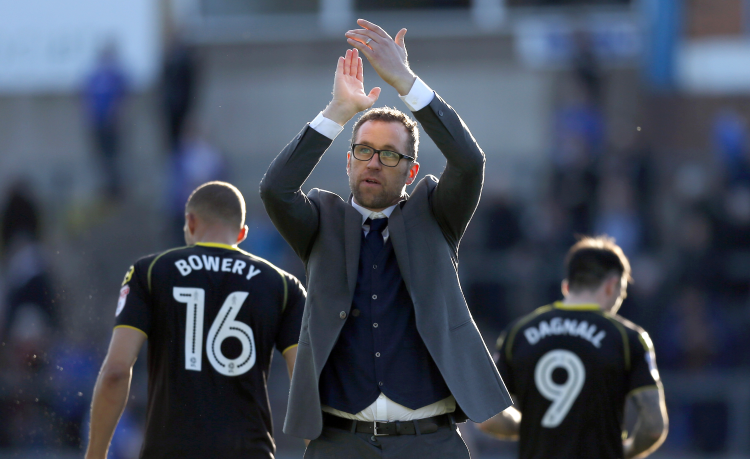
| Area | Up to half a pitch |
| Equipment | Balls, bibs, cones, poles, mannequins, 1 full size goal |
| No. of Players | Up to 16 players |
| Session Time | Practice 1: 10mins Practice 2: 30mins Practice 3: 30mins |
This session is all about building relationships in wide areas. The players are given guidelines but they also have lots of freedom to break down a low block or a set defence.
I like this session because there is structure to help the players create goal scoring opportunities but the session doesn’t stifle creativity or the individual’s freedom to express themselves. The better the relationships and understanding in this session, the more chances will be created.
There are specific technical points that will stimulate player learning and as the session is about scoring goals, the vast majority of the players are automatically engaged.
I tend to run the session, or one very similar, every couple of weeks, as I believe it’s really important to build and maintain relationships whilst also reaffirming one of the main ways in which the team will create goal scoring opportunities. Our opponent’s tactics may also lead us towards this session if, for example, we believe they are a counter-attacking team.
“I like this session because there is structure to help the players create goal scoring opportunities but the session doesn’t stifle creativity”
Practice 1
We set up a playing area of 60x30 yards, with a central 20-yard square marked out by mannequins. We’re using 14 outfield players positioned as shown. There are two balls in play at the same time, with one passing pattern starting on the left side and one passing pattern starting on the right side. The players perform the passing patterns beginning as shown [1a]...
[1a]
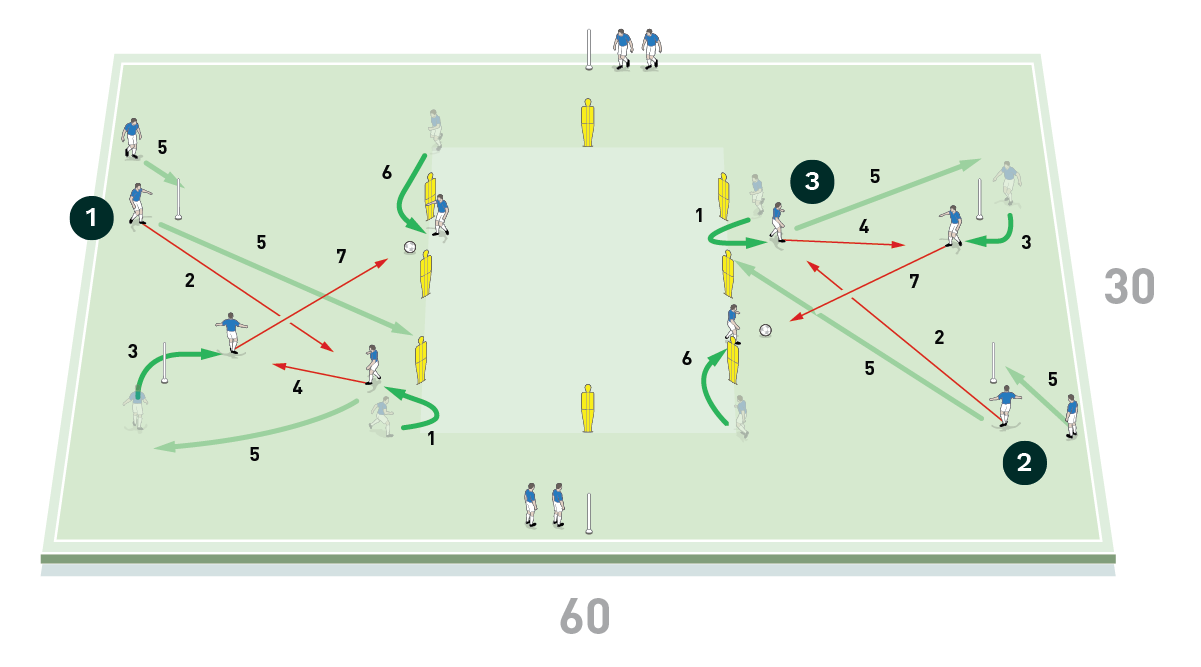
- There are two balls in play at the same time, with one passing pattern starting here on the left side
- A second passing pattern starts here on the right
- All passes should be one touch but a different weight of pass is needed each time
...and continuing as shown [1b].
[1b]
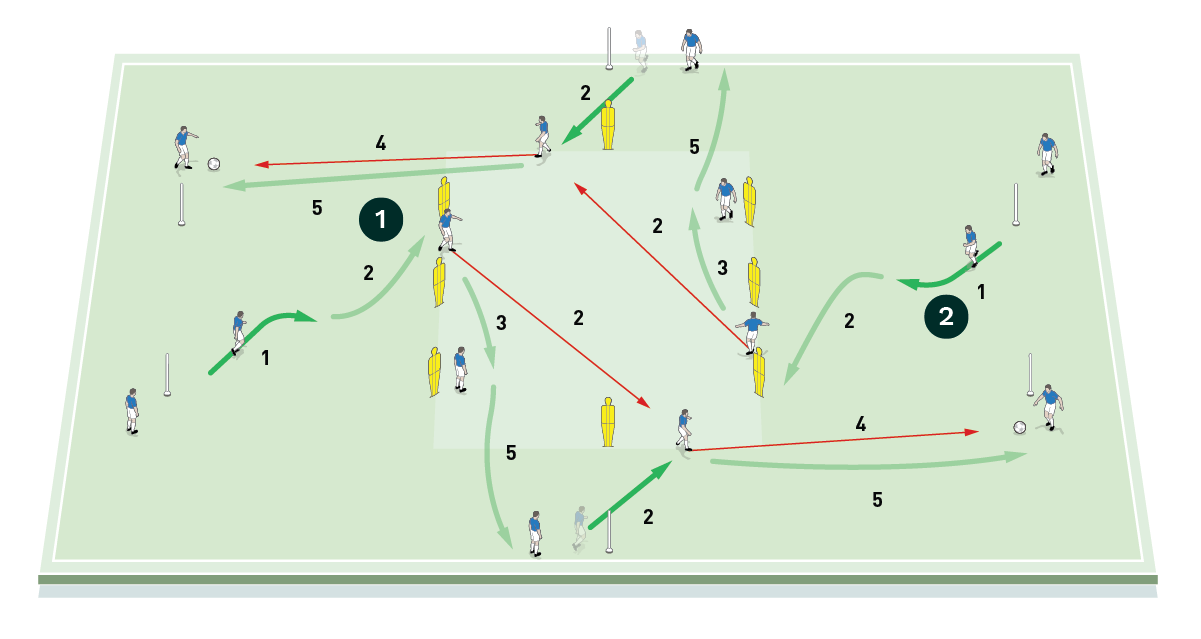
- The passing patterns continue
- Players must move off their markers before receiving the ball and all movements and passes should be angled
All passes should be one touch but a different weight of pass is needed each time depending on the circumstances. Players must move off their markers before receiving the ball and all movements and passes should be angled as we don’t want to see any straight runs made towards the player passing the ball or any straight passes.
Coaches should be aware of who understands the movement the quickest and the relationship of movement when other players and other balls are moving, because they are more likely to succeed when opposition players are introduced.
Practice 2
We set up a playing area of 18x12 yards, with a centre line marked out with cones. We’re using nine outfield players split into three teams of three. Two yellow centre backs start at one end, with one yellow at the other end, while all three blues and all three reds begin inside the main playing area, with players marking their opponents.
A yellow centre back starts with the ball and plays it into a red in the centre of the playing area. The blues press and try to win possession while the red team must work the ball to the lone yellow player at the other end. The receiving yellow end player passes it back to one of the red attackers, who then dribbles over the end line to score a point, as shown [2a].
[2a]
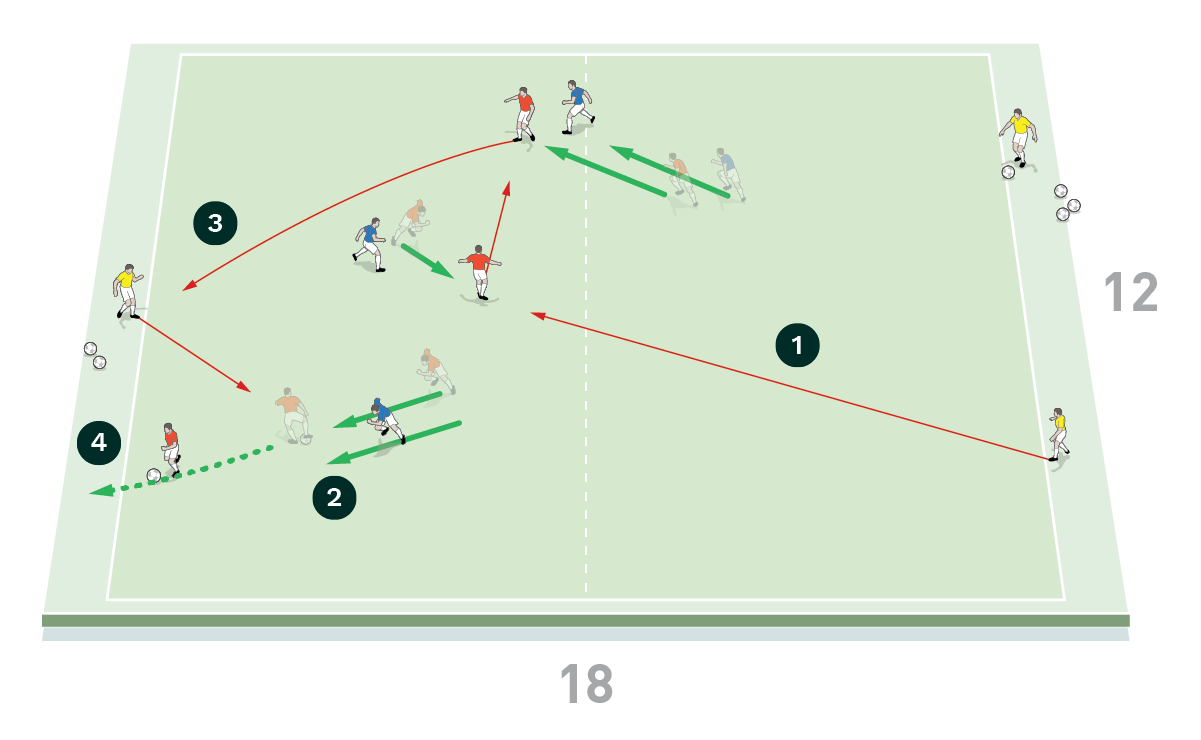
- A yellow centre back starts with the ball and plays it into a red in the centre of the playing area
- The blues press the reds and try to win possession
- The red team must resist the blue pressure and work the ball to the lone yellow player on the end line
- The yellow plays the ball back to a red striker who receives and dribbles the ball over the end line to score a point
Once a player has run the ball over the end line, the game starts again with a pass out from a yellow centre back but this time the starting pass is played into a blue and the reds are now the defending team. The reds press and if they win the ball, as shown [2b].
[2b]
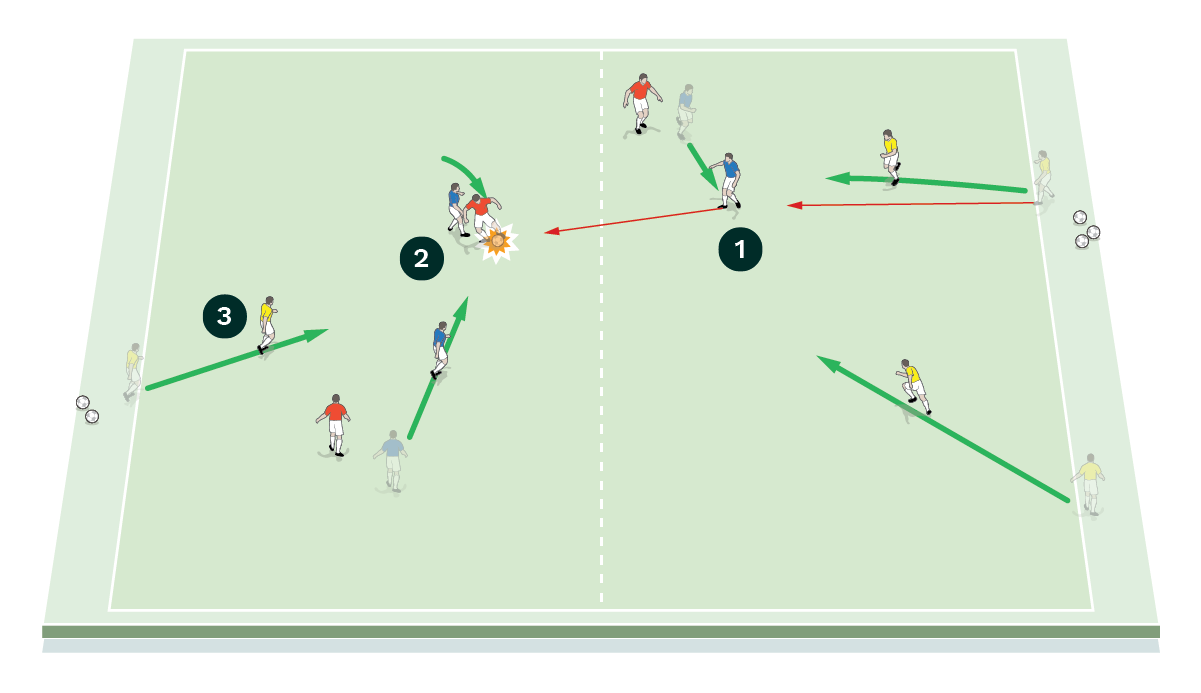
- The game restarts with a yellow centre back but this time the starting pass is played into a blue
- The reds are now the defending team. Here they win the ball and must try to work it to a red striker to dribble over the end line
- When the defending team wins the ball, the three yellows enter the playing area and join with the blue team in transitioning quickly to counter-press the reds to stop them scoring
The three outside yellows enter the playing area and join with the blue team in transitioning quickly and aggressively to counter-press the reds and prevent them from dribbling the ball over the end line to score.
In this activity we want to see outside players remaining alert and constantly moving to create angles for the player on the ball. We also want to see attacking players moving the ball quickly to exploit opportunities to get in behind and they should be communicating with their body language and voices.
Practice 3
We set up a playing area on half a pitch with a full size goal and goalkeeper at one end. Two 30x15-yard corner zones are marked out as shown.
We’re using 16 outfield players split into two teams of eight. The blue team attacks and the red team defends, but the players must remain in their zones. There is a 3v3 in each corner zone and a 2v1 in favour of the reds in the penalty box, plus a blue holding midfielder starts play with a ball from the edge of the centre circle. The blue team aims to work the ball into a position to score a goal, as shown [3].
[3]
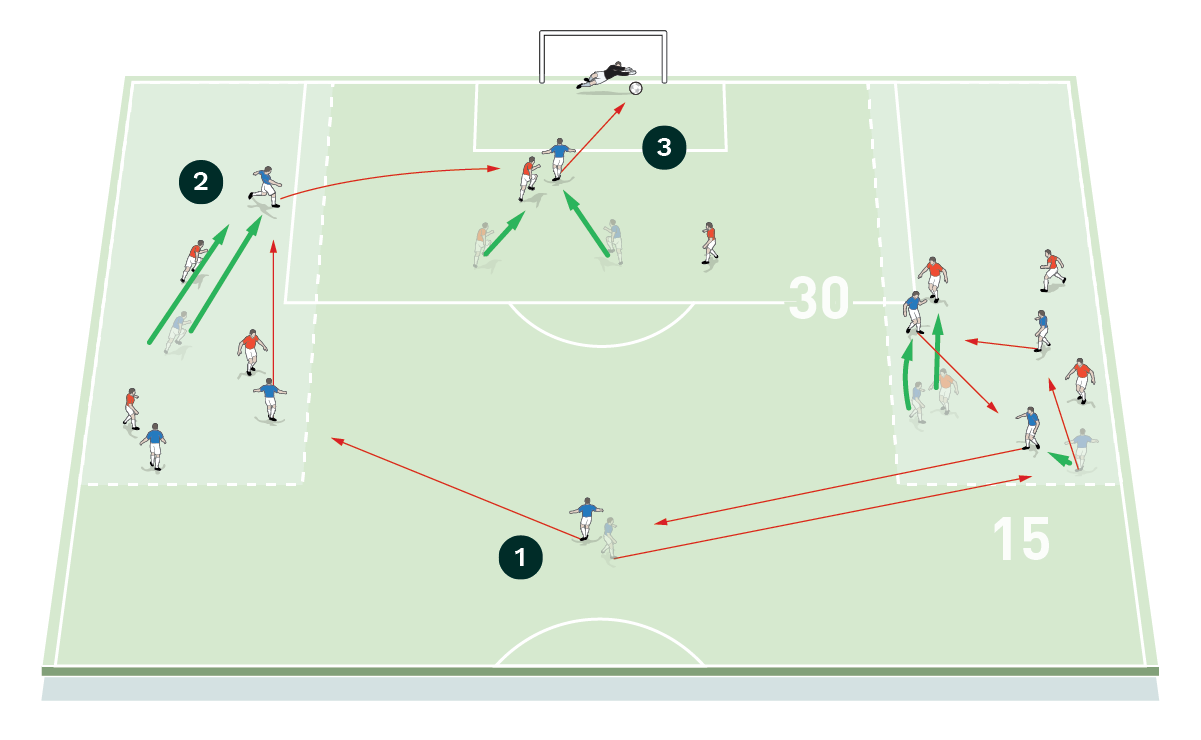
- A blue holding midfielder starts play with a ball from anywhere in the midfield. The blue team aims to work the ball into a position to score a goal
- There is a 3v3 in each corner zone and players are locked into their zones. The blue wide player should try to get behind the red defenders and cross
- There is a 2v1 in favour of the reds in the penalty box and the blue striker beats the defenders to meet the cross and finishes with a shot on goal
We want to see attackers making runs to get in behind the defence even if the ball doesn’t come to them, but attackers should also be patient and resist trying to force the play.
We play for four blocks of seven minutes, with the teams switching roles after each block.
COACHING POINTS
What are the key things to look for?
We want to see that players know automatically where to run to in order to receive the ball or get in behind and therefore create a lot of chances from dangerous areas.
Sharp, dynamic movements are really helpful and players should be able to read their team mates’ body language, which is a clear sign that players are on the same page.
What are the typical mistakes players might make and how do I avoid them?
Players can sometimes get frustrated due to a lack of patience and try forcing the ball. They expect the activity to work straightaway, not realising they have to understand each other’s strengths as well as their own for it to work.
Repetition of these practices is key but they must be performed at match speed.
Editor's Picks
Attacking transitions
Deep runs in the final third
Using the goalkeeper in build-up play
Intensive boxes drill with goals
Penetrating the final third
Creating and finishing
My philosophy
Pressing initiation
Compact team movement
Coaches' Testimonials

Alan Pardew

Arsène Wenger

Brendan Rodgers

Carlos Carvalhal

José Mourinho

Jürgen Klopp

Pep Guardiola

Roy Hodgson

Sir Alex Ferguson

Steven Gerrard
Coaches' Testimonials

Gerald Kearney, Downtown Las Vegas Soccer Club

Paul Butler, Florida, USA

Rick Shields, Springboro, USA

Tony Green, Pierrefonds Titans, Quebec, Canada
Join the world's leading coaches and managers and discover for yourself one of the best kept secrets in coaching. No other training tool on the planet is written or read by the calibre of names you’ll find in Elite Soccer.
In a recent survey 92% of subscribers said Elite Soccer makes them more confident, 89% said it makes them a more effective coach and 91% said it makes them more inspired.
Get Monthly Inspiration
All the latest techniques and approaches
Since 2010 Elite Soccer has given subscribers exclusive insight into the training ground practices of the world’s best coaches. Published in partnership with the League Managers Association we have unparalleled access to the leading lights in the English leagues, as well as a host of international managers.
Elite Soccer exclusively features sessions written by the coaches themselves. There are no observed sessions and no sessions “in the style of”, just first-hand advice delivered direct to you from the coach.









